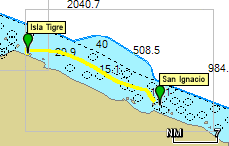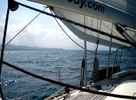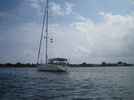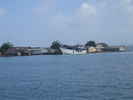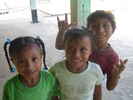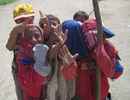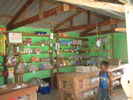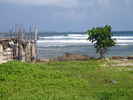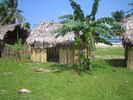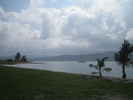25 nm, mostly sailing, to Isla TigreAfter our wonderful stay at Tupile San Ignacio, it was time to start working our way west again, so we decided to go to Isla Tigre, a place we had not yet visited. There was no real wind when we left the anchorage at about 9:00 am, but by the time we got out a bit, there was a good sailing wind, so we put up the canvas and were able to turn off the motor for about 1/2 of the 25 nm passage. After we passed the north side of the island, we turned into the wind and put the sails away and made our way carefully through the reef bound passage into the lee of Isla Tigre, using waypoints from the Bahaus book to guide us. We dropped anchor in about 25' of water at the recommended anchorage, right off of a concrete building on the shore. Almost as soon as we arrived, a motorized ulu came out with the island officials who charged us $10 for a one month permit to visit the island and anchor there. They invited us to the congresso, a nightly meeting of the villagers, but we declined for the evening due to the likelyhood of rain that night. As they were leaving for shore, their outboard motor developed a problem, and via a series of hand signals, they indicated that they would like a tow back to shore. So I got in the dinghy and towed them to shore, returning to RHAPSODY a few minutes later. The afternoon turned grey and rainy, and so we decided to forego visiting the island until the next day, and spent the rest of the afternoon and evening on RHAPSODY, writing web pages, playing a bit of guitar, having cocktails and dinner, and so on. On the next day, Saturday, December 6th, we brought the dinghy to shore to explore the island. We tied the dinghy off on a small rickety wooden dock next to the concrete government dock, and climbed out as a number of children greeted us, full of curiosity and smiles. We spent the morning and early afternoon walking the entire island. On Tigre, the natives are not allowed to approach anchored yachts in their ulus to sell fish, molas, and so on, and in fact, in general, they are not supposed to approach strangers at all to sell things, so as we made our way around the island, the women who wanted to sell us molas would furtively gesture to us to come see their wares. Right next to the dock there was a fairly well-stocked tienda. We stuck our heads in and decided we would stop there later for a few provisions on the way back to the boat. The tienda at the government dock was near the social center of the island, the congresso hut, and so we walked by it as we first got to the island. We peeked inside, but could tell there was something going on, and from the body language of the people around the hut, it was pretty clear that we should not intrude, so we went onwards. Just past the congresso, we ran into an English speaking man, Pedro, who told us about himself and some things about the island. He said he had worked for many years in Panama City at an American Army base as a cook, which explained his excellent English skills. He showed us into the new house he was building and told us about the techniques for building it, elaborating that he only had to finish the roof before it would be completed. When we asked him about the gathering at the congresso, he told us that the previous night an elderly man had passed away, at the ripe old age of 78, and they were having a funeral service for him in the congresso. That explained the soft chanting and wailing of the women that we heard coming from the hall and the feeling we had as we walked by it earlier. He then introduced us to his sister, who lived right across the way from his hut, and said that she would like us to take a picture of her preparing a traditional Kuna lunch, of fish and plantains, which we did, for one dollar. From there, we walked along the island, stopping occasionally to look at molas and wares that the women had for sale. At one point we found a set of nice mola caps that we purchased from a maternal family group consisting of three women of various ages. From there, we walked out to the airstrip, littered and unusable, with weeds growing up through cracks in the concrete. When we got to the end of the airstrip, we found ourselves at a nature reserve and "resort", where we stopped at the island's only restaurant to have a soda and talk with the owner. He explained that the islanders had decided to close the airstrip some twenty years earlier when a child was killed by a landing airplane. After that tragedy, the people decided that the airstrip was too dangerous for the kids, so they tore parts of it up so that airplanes could no longer land, forcing the airline to stop sending planes to the island. He pointed out the huts that were for rent to tourists. The open air huts were about $5 a day, and the closed huts, with beds and even one with electricity, were about $15 a day. He told us there was another couple, from Holland, visiting the island, and we figured we'd run into them at some point. We continued our walk of the island, going all the way out to the western end of it and taking a few photos. Then we worked our way back down the "main street" of the island, stopping by a wood carver's hut to see his work, and being surreptitiously approached by a few more mola selling ladies. As we got near the other end of the island, sure enough, we ran into the Dutch couple as they too were strolling around the island. Near what looked to be another community hut, like another congresso building, we ran into a man named Fidel, who re-iterated the invitation to the evening congresso, but who also explained that there was to be a chicha festival the next day, on Sunday, to celebrate Panama's Mother's Day. Chicha is the home-brewed alcoholic beverage that the islanders make from sugar cane, and which they use in their regular celebrations. When we asked some more about it, Fidel took us inside the large hut and showed us the Chicha pottery jars where the mixture was nearing the end of its 8-day fermentation cycle. He explained how it was made, said that it would be ready the next day, and invited us back to imbibe. From there, we walked on to the east end of the island, where we encountered the concrete buildings of the school, which was not in session. The courtyard and basketball court were empty and forlorn-looking. In general, we were struck by how different Tigre was from our visit to the other island, Tupile. Perhaps Tigre was just more sedate due to the funeral in progress, or perhaps it was because there was no church present on Tigre, where there had been a big Catholic church on Tupile, or perhaps it was just the physical organization of the island, with the school being out on the end instead of in the center; but for one reason or another, Isle Tigre did not seem as vibrant, alive, or well-to-do, or the people as happy and healthy as those we had found on Isle Tupile. The long and short of it is that we did not connect with the people on Tigre as we had with the folks on Tupile, so after we finished our tour, stopped by the tienda to pick up oatmeal and eggs, got back in the dinghy and returned to RHAPSODY, we decided that we would not go to the congressso that evening, nor hang around the next day for the Mother's Day Chicha festival. On Sunday morning, then, we pulled up anchor and headed away from Isla Tigre. |

